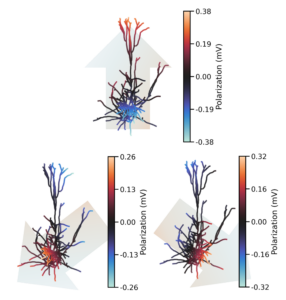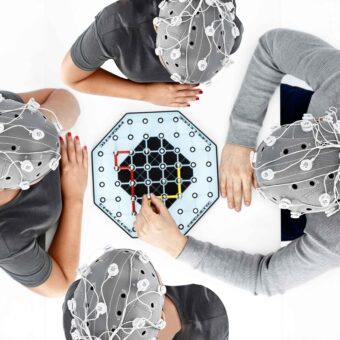A mathematical model is a way to describe how things work using numbers and equations. Modeling helps us understand complex things by breaking them down into smaller, simpler parts that we can study more easily. In the research branch of the modeling department, we are trying to build models that can describe the electrical activity of the brain as a whole. Why? We believe that all brains have singularities that have to be taken into account to design better therapies.
With this in mind, we try to make what we call “digital twins” of brains that we can use to find the best brain stimulation electrical therapy tailored for the individual. A central piece of this big challenge is describing how the low electric fields that transcranial stimulation delivers in the outer part of the brain – what we call the cortex – affect the different neurons that live there. And this month we are sharing with you a study we carried out to solve this little piece of the puzzle.
Creating a method to anticipate the effects of tDCS in neurons
The quest from the study was to put some math into play that could describe the effect of transcranial direct current stimulation (tDCS) in neurons. We used neuron models from juvenile rats (Markram et. al 2015) as a starting point for our framework, but with the idea that the framework could be applied to cell models of other species – like humans. We wanted to measure the effect of weak electric fields on neurons, so we used a perspective to see how things change in time, what in mathematics we call “dynamical systems”. We measured how much we could displace something called the “stable equilibrium” of a neuron model when a weak electric field is applied.
That is, how would what the neuron would do change if nothing disturbs it with or without the electric field? By measuring this displacement, we could tell if it was more likely for the neuron to be activated and send signals to other neurons (what we call spike) or not. If for instance, we make neurons less likely to spike, we call it inhibitory stimulation – and it is something we usually look for in patients suffering from focal epilepsy. However, the framework we developed applies under tDCS assumptions and it would not, for example, work well if the neuron was oscillating.
We know that neurons respond differently to the direction in which the electric field is applied. To represent different effects in different directions we used a math tool called “spherical harmonics“. This tool allows us to describe the effect of the electric field in any direction. With it, we found that there was one type of response, called “dipolar,” that was present in most cases. This type of response is very convenient because we can model it with a simple dot product calculation. This means that if you align the field with the preferred direction of the neuron, the effect is maximum and that reversing the direction reverses the effect.

But we also found that there were other responses that were not dipolar. Specifically, we saw differences in the size of the effect of the field when reversing the orientation. However, we only observed this response in neuron models when they were very close to being activated.
The diversity of neuronal responses to tDCS
There are many types of neurons in the cortex, and different neurons in the brain respond differently to electric fields. It was already known that some are more sensitive than others. What was really interesting for us was quantifying them for different cell types and cellular regions. With the mathematical framework we developed, we can predict the response of different cell types in isolation.
We saw that the most affected cells were some “pyramidal cells” – a type of excitatory neuron of the cortex. Specifically, those living in the lower layers of the cortex (in layers V and VI). This is aligned with results reported by prior studies. We noticed that these cells have an increased effect when they have more little branches at the very top – what we call the tuft. The more branched the tuft is, the larger the effect is felt at the cell body.
Also, we observed that most interneurons, which are another type of cortical neurons that are usually smaller, are less affected than the large pyramidals. However, because there are a lot of types of interneurons, their response is also very diverse. For instance, a type called basket cells, showed the smallest response at the level of the cell body in all their different types and layers from the types we studied – but other types like bipolar cells showed effects comparable to those we saw in models of pyramidal cells in some cases.
In addition, we observed how different parts of the cells respond differently to electric fields, with some parts being more vulnerable than others. We even created functions for the major regions of the cell by averaging the responses across the regions.
To sum up, our study provided a framework for quantifying and predicting the effects of weak electric fields on neurons. You can find all the technical details of the modeling approach in Galan-Gadea et. al 2023. We hope that building models at this single level and integrating them in whole-brain models will lead to a better understanding of how the brain stimulation affects its dynamics and help us develop new treatments for brain disorders. Who knows, with continued study and innovation, we may one day be able to harness the power of weak electric fields to unlock new secrets of the brain and treat conditions that were once thought untreatable. The future is electrifying!



